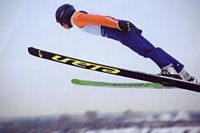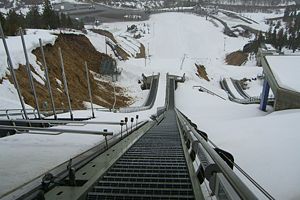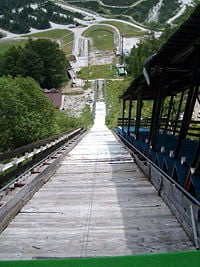Ski jumping
Ski jumping is a sport in which skiers go down an inrun with a take-off ramp (the jump), attempting to go as far as possible. In addition to the length that skiers jump, judges give points for style. The skis used for ski jumping are wide and long (240 to 270 cm). Ski jumping is predominantly a winter sport, performed on snow, and is part of the Winter Olympic Games, but can also be performed in summer on artificial surfaces (porcelain or frost rail track on the inrun, plastic on the landing hill).
History
Ski jumping originates from Morgedal, Norway, but the first proper competition was held in Trysil in 1862. The first widely known ski jumping competition was the Husebyrennene, held in Oslo from 1879. The annual event was moved to Holmenkollen from 1892, and Holmenkollen has remained the Mecca of ski jumping ever since.
Competition

Today, World Cup ski jumping competitions are held on three types of hills:
- Normal hill competitions:- for which the calculation line is found at approximately 80-100m. Distances of up to and over 110 metres can be reached.
- Large hill competitions:- for which the calculation line is found at approximately 120-130m. Distances of over 145 m can be obtained on the larger hills. Both individual and team competitions are run on these hills.
- Ski-flying competitions:- for which the calculation line is found at 185 m. The Ski Flying World Record is currently held by Bjørn Einar Romøren (239m), set in Planica (SLO) in March 2005.
Amateur and junior competitions are held on smaller hills.
Individual Olympic competition consists of a training jump and two scored jumps. The team event consists of four members of the same nation who have two jumps each.
Ski jumping is one of the two elements in the Nordic combined sport.
Women's ski jumping
Currently, women ski jump internationally in the Continental cup. On May 26, 2006, the International Ski Federation decided to allow women to ski jump at the 2009 Nordic World Ski Championships in Liberec, Czech Republic and then to have a team event for women at the 2011 world championships. FIS also decided to submit a proposal to the International Olympic Committee to allow women to compete at the 2010 Winter Olympics in Vancouver.[1] On November 28, 2006, the proposal was rejected by the Executive Board of the IOC. The reason for the rejection cited the low number of athletes as well as few participating countries in the sport. The Executive Board noted that women's ski jumping has yet to be fully established internationally.[2]
Scoring
The winner is decided on a scoring system based on distance and style.
Each hill has a target called the calculation point (or K point) which is a par distance to aim for. This point is marked by the K line on the landing strip. For K90 and K120 competitions, the K line is at 90 m and 120 m respectively. Skiers are awarded 60 points if they land on the K Line. For every metre short/beyond this average, jumpers receive fewer/more points than the par 60 (1.8 points per metre).
In addition, five judges are based in a tower that lies to the side of the expected landing point. They can award up to 20 points for style based on: keeping the skis steady during flight, balance, good body position and landing.
The final score consists of the distance score plus the middle three style scores from the judges (the highest and lowest scores are ignored). For the individual event, the jumper with the best combined total from his two jumps is the winner.
Technique
Using the modern V-technique, pioneered by Jan Boklöv of Sweden in 1985, world-class skiers are able to exceed the distance of the take-off hill by about 10 percent compared to the previous technique with parallel skis. Aerodynamics has become a factor of increasing importance in modern ski jumping, with recent rules addressing the regulation of ski jumping suits. This follows a period when loopholes in the rules seemed to favour skinny jumpers in stiff, air foil-like suits.
Previous techniques first included the Kongsberger technique, developed in Kongsberg, Norway by two ski jumpers, Jacob Tullin Thams and Sigmund Ruud following World War I. This technique had the upper body bent at the hip, a wide forward lean, and arms extended the front with the skis parallel to each other. It would lead to jumping length going from 45 meters to over 100 meters. In the 1950s Andreas Daescher of Switzerland and Erich Windisch of Germany modified the Kongsberger technique by placing his arms backward toward his hips for a closer lean. The Daescher technique and Windisch technique would be standard for ski jumping from the 1950s until the V-style technique was developed in 1985.
The skiers have to touch the ground in the Telemark landing style. This involves the jumper landing with one foot in front of the other, mimicking the style of the Norwegian inventors of Telemark skiing. Otherwise the style points will be reduced.
Popularity
Ski jumping is popular among spectators and TV audiences in Scandinavia and Central Europe. Almost all world-class ski jumpers come from those regions or from Japan. Traditionally, the strongest countries (with consistently strong teams) are Finland, Norway, Germany (formerly both East and West), Austria, Poland and Japan. However, there have always been successful ski jumpers from other countries as well (see list below). The Four Hills Tournament, held annually at four sites in Bavaria (Germany) and Austria around New Year, is very popular and draws huge crowds.
There have been attempts to spread the popularity of the sport by finding ways by which the construction and upkeep of practising and competition venues can be made easier. These include plastic "fake snow" to provide a slippery surface even during the summer time and in locations where snow is a rare occurrence.
Notable ski jumpers
Former World Cup ski jumpers
- Per Bergerud (Norway)
- Jan Boklöv (Sweden)
- Sepp Bradl (Austria)
- Espen Bredesen (Norway)
- Roberto Cecon (Italy)
- Andreas Daescher (Switzerland)
- Matjaž Debelak (Yugoslavia/Slovenia)
- Christof Duffner (West Germany/Germany)
- Andreas Felder (Austria)
- Wojciech Fortuna (Poland)
- Kazuyoshi Funaki (Japan)
- Andreas Goldberger (Austria)
- Lars Grini (Norway)
- Sven Hannawald (Germany)
- Masahiko Harada (Japan)
- Jeff Hastings (USA)
- Mike Holland (USA)
- Anton Innauer (Austria)
- František Jež (Czechoslovakia/Czech Republic)
- Veikko Kankkonen (Finland)
- Yukio Kasaya (Japan)
- Armin Kogler (Austria)
- Mark Konopacke (USA)
- Jiří Malec (Czechoslovakia)
- Toni Nieminen (Finland)
- Ari-Pekka Nikkola (Finland)
- Matti Nykänen (Finland)
- Lasse Ottesen (Norway)
- Jiří Parma (Czechoslovakia/Czech Republic)
- Franci Petek (Yugoslavia/Slovenia)
- Pavel Ploc (Czechoslovakia/Czech Republic)
- Jari Puikkonen (Finland)
- Jiří Raška (Czechoslovakia)
- Helmut Recknagel (East Germany)
- Birger Ruud (Norway)
- Roger Ruud (Norway)
- Sigmund Ruud (Norway)
- Jaroslav Sakala (Czechoslovakia/Czech Republic)
- Jani Soininen (Finland)
- Walter Steiner (Switzerland)
- Dieter Thoma (West Germany / Germany)
- Primož Ulaga (Yugoslavia/Slovenia)
- Ernst Vettori (Austria)
- Jens Weissflog (East Germany/Germany)
- Bjørn Wirkola (Norway)
Currently active
 Adam Małysz
Adam Małysz Janne Ahonen
Janne Ahonen Simon Ammann
Simon Ammann Lars Bystøl
Lars Bystøl Janne Happonen
Janne Happonen Matti Hautamäki
Matti Hautamäki Martin Höllwarth
Martin Höllwarth Anders Jacobsen
Anders Jacobsen Jakub Janda
Jakub Janda Noriaki Kasai
Noriaki Kasai Andreas Kofler
Andreas Kofler Andreas Küttel
Andreas Küttel Arttu Lappi
Arttu Lappi Veli-Matti Lindström
Veli-Matti Lindström Roar Ljøkelsøy
Roar Ljøkelsøy Wolfgang Loitzl
Wolfgang Loitzl Thomas Morgenstern
Thomas Morgenstern Primož Peterka
Primož Peterka Sigurd Pettersen
Sigurd Pettersen Stefan Read
Stefan Read Bjørn Einar Romøren
Bjørn Einar Romøren Gregor Schlierenzauer
Gregor Schlierenzauer Martin Schmitt
Martin Schmitt Georg Späth
Georg Späth Michael Uhrmann
Michael Uhrmann Andreas Widhölzl
Andreas Widhölzl Roman Koudelka
Roman Koudelka
Notable unsuccessful ski jumpers
- Vinko Bogataj - Best known as "The Agony of Defeat" because the constant use of footage of his spectacular tumble in the title sequence of ABC's Wide World of Sports
- Eddie 'the Eagle' Edwards - Popular favourite at the 1988 Winter Olympics
Notable female ski jumpers
- Anette Sagen (Norway)
- Eva Ganster (Austria)
- Lindsey Van (USA)
- Daniela Iraschko (Austria)
Important venues
Ski jumping World Cup
 Engelberg, Switzerland
Engelberg, Switzerland Harrachov, Czech Republic
Harrachov, Czech Republic Kulm, Austria
Kulm, Austria Kuusamo, Finland
Kuusamo, Finland Liberec, Czech Republic
Liberec, Czech Republic Planica, Slovenia
Planica, Slovenia Sapporo, Japan
Sapporo, Japan Trondheim (Granåsen), Norway
Trondheim (Granåsen), Norway Vikersund (Vikersundbakken), Norway
Vikersund (Vikersundbakken), Norway Willingen, Germany
Willingen, Germany Zakopane, Poland
Zakopane, Poland
Four Hills Tournament
 Innsbruck (Bergisel), Austria
Innsbruck (Bergisel), Austria Oberstdorf, Germany
Oberstdorf, Germany Garmisch-Partenkirchen, Germany
Garmisch-Partenkirchen, Germany Bischofshofen, Austria
Bischofshofen, Austria
Nordic Tournament
 Lahti, Finland
Lahti, Finland Kuopio (Puijo), Finland
Kuopio (Puijo), Finland Lillehammer (Lysgårdsbakkene), Norway
Lillehammer (Lysgårdsbakkene), Norway Oslo (Holmenkollen), Norway
Oslo (Holmenkollen), Norway
Ski flying
Ski flying is an extreme version of ski jumping. The events take place on big hills with a K-spot on at least 185 meters. There are five ski flying hills in the world today. Vikersundbakken in Vikersund, Norway; Oberstdorf, Germany; Kulm, Austria; Letalnica; Planica, Slovenia; and in Harrachov, Czech Republic. The sixth hill, Copper Peak in the western Upper Peninsula of Michigan, is currently disused although there are some plans to rebuild it to FIS standards. [1] The biggest hill is in Planica, where all the longest ski jumps have been jumped. It's possible to jump over 200 meters in all the ski flying hills, and the current World Record is 239 meters, set by Norwegian Bjørn Einar Romøren in Planica 2005. The longest ever jump was actually 240 meters long, achieved by Janne Ahonen at the same competition, but it has not been homologated as the record because Ahonen fell as soon as he landed. Since 1972 there's been held a Ski flying World Championship every other year.
National records
| Rank | Nation | Record holder | Length |
| 1. | Bjørn Einar Romøren | 239 meters | |
| 2. | Matti Hautamäki | 235.5 meters | |
| 3. | Andreas Widhölzl | 231 meters | |
| 4. | Robert Kranjec | 229 meters | |
| 5. | Dimitri Vassiliev | 228 meters | |
| 6. | Michael Neumayer | 227.5 meters | |
| 7. | Adam Małysz | 225 meters | |
| 8. | Daiki Ito | 222.5 meters | |
| 9. | Alan Alborn | 221.5 meters | |
| 10. | Isak Grimholm | 207.5 meters | |
| 11. | Eddie 'the Eagle' Edwards | 105 meters |
Water ski jumping
The ski jump is performed on two long skis similar to those a beginner uses, with a specialized tailfin that is somewhat shorter and much wider (so it will support the weight of the skier when he is on the jump ramp.) Skiers towed behind a boat at fixed speed, manoeuver to achieve the maximum speed when hitting a ramp floating in the water, launching themselves into the air with the goal of travelling as far as possible before touching the water. Professional ski jumpers can travel up to 70 metres. The skier must successfully land and retain control of the ski rope to be awarded the distance.
See also
- Skiing and Skiing Topics
- Ski jumping World Cup
- Freestyle skiing
- Ski jumping at the Winter Olympics
ReferencesISBN links support NWE through referral fees
- ↑ http://www.fis-ski.com/uk/newsinformation/pressreleases/pressreleases2006/gacongressdecisions.html FIS MEDIA INFO: Decisions of the 45th International Ski Congress in Vilamoura/Algarve (POR)
- ↑ http://www.iht.com/articles/ap/2006/11/28/sports/ME_SPT_OLY_IOC_Meetings.php IOC approves skicross; rejects women's ski jumping
External links
- Olympic Ski Jumping History
- World's longest ski jump Bjørn Einar Romøren video
Credits
New World Encyclopedia writers and editors rewrote and completed the Wikipedia article in accordance with New World Encyclopedia standards. This article abides by terms of the Creative Commons CC-by-sa 3.0 License (CC-by-sa), which may be used and disseminated with proper attribution. Credit is due under the terms of this license that can reference both the New World Encyclopedia contributors and the selfless volunteer contributors of the Wikimedia Foundation. To cite this article click here for a list of acceptable citing formats.The history of earlier contributions by wikipedians is accessible to researchers here:
The history of this article since it was imported to New World Encyclopedia:
Note: Some restrictions may apply to use of individual images which are separately licensed.


